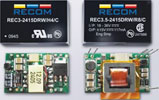

DC/DC converters typically offer galvanic input to output isolation. Depending on the converter, the isolation voltage can be as low as 1 kV d.c. or as high as 10 kV d.c.
The isolation rating is functional isolation. However, UL defines three classes of isolation quality: functional, basic and reinforced. Sophisticated applications in medical or power electronics often require ‘reinforced’ isolation for isolation strengths higher than 6 kV d.c.
Isolated DC/DC converters have many advantages: the galvanic isolation breaks ground loops and therefore removes signal noise from circuits; it allows information to be transmitted between two independent circuits by remotely powering one circuit from another; it permits positive-to-negative and negative-to-positive voltage conversion; it allows many units to share a common information and power bus without concern that if one module fails that it will pull down the entire network; and, most importantly, it acts as a safety barrier to prevent electric shock and to avoid the possibility of excessive current flow that could cause overheating or start a fire.
Although 1 kV d.c. sounds impressive, the transformer construction is very simple. A typical low-power DC/DC converter will use an internal toroidal or bobbin-type transformer consisting of primary and secondary windings of magnet wire wound upon a ferrite core. Even if the insulation on one winding fails, the insulation on the other winding can still withstand the full 1 kV d.c. test voltage. This means that the input and output windings can be wound directly on top of one another without compromising the electrical isolation. This class of isolation is called operational or functional isolation.
However, although a transformer with functional isolation is reliable and safe for most industrial and commercial applications, for safety critical applications or for isolation ratings higher than 6 kV d.c., it is not permitted or desirable to wind the input and output windings directly on top of one another. They must be separated.
Reinforced isolation
Considering that an industry standard low-power DC/DC converter is in a DIP24 case with outside dimensions of around 32 x 20 x 10 mm, it is not surprising that almost all DC/DC converters incorporate either functional isolation or basic isolation. A transformer with a creepage separation of over 4,6 mm as required by UL would be unlikely to be able to fit into a case that is only 10 mm high.
Despite the separation requirement challenges, Recom’s engineers have developed a DIP24-sized DC/DC converter that meets all of the requirements for reinforced isolation.
The standard converter on the left of the image uses a bobbin transformer with functional isolation. The reinforced isolation converter on the right uses a completely new (patent pending) transformer construction that guarantees a minimum clearance separation of 2,4 mm. The yellow coloured plastic film in the photograph is there to ensure the minimum creepage separation of 4,6 mm. The transformer uses an internal construction with multiple layers of insulation and separation barriers to meet the requirements.
Previous attempts to build a compact transformer with reinforced isolation have not met with much success, the main reason being that the efficiency of the transformer decreases if the electric and magnetic fields within the transformer are not closely coupled together. However, in order to meet the clearance requirements for reinforced isolation, there have to be gaps and physical barriers between the input and output windings.
This provides engineers with a real technical challenge. A standard DC/DC converter has a typical efficiency of around 84%. This means that a 3 W output rated converter will consume 3,6 W of power at full load. The 600 mW difference between input and output manifests itself as heat. At high ambient temperatures, this internal power dissipation limits the maximum operating temperature of the converter. If a converter is constructed with a lower efficiency transformer – say 75% – then the internal power dissipation increases to 1 W. This will sharply reduce the maximum operating temperature from +85°C to only +71°C – which is not acceptable for many industrial applications.
Recom has developed a patent pending transformer and driver system that meets all of the requirements for reinforced isolation but also with higher efficiency. Thus the converters can deliver 20% more power with the same efficiency as their functional isolation-only equivalents. Thus the REC3.5-R8/R10 offers 3,5 W of power with either 8 kV d.c. or 10 kV d.c. of reinforced isolation and the REC6-R8/R10 offers 6 W of power with either 8 kV d.c. or 10 kV d.c. of reinforced isolation. All converters are UL and CSA certified for both industrial and medical applications.
| Tel: | +27 21 706 3162 |
| Email: | [email protected] |
| www: | www.brabek.co.za |
| Articles: | More information and articles about Brabek |

© Technews Publishing (Pty) Ltd | All Rights Reserved